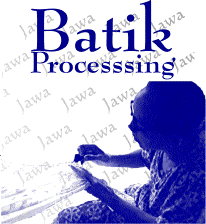

|
In the Western World, the Industrial Age led to the creation of a middle class, but in its wake destroyed much of the craftsmanship that could no longer compete with modern machines. Mass produced goods have increased the variety of goods you and I can purchase when compared with our ancestors, but the quality, beauty, and perhaps even soul of a machine produced good can never truly compare to that produced by craftsmen. Although "craftsmanship" is probably an ill-used term when speaking of the batik process, the term is used to convey the relation of craftsmen-produced goods relative to mass, machine-produced goods, to those unfamiliar with Southeast Asian cultures. First of all, batik process in Indonesia was traditionally a village activity, and a family enterprise. Labor in the process was differentiated by sex as well as age. The 'bringing to life' of the motifs on cloth with hot wax using a canting was reserved for married women in their reproductive years. Specific colors were representative of specific areas. The introduction of a cash economy on Java in the Nineteenth Century forever changed this. Today, batik is produced in shops. The dyes used on the cloth is typically imported. Cotton may be found domestically, but silk is imported. Foreign goods and influences have shaped batik for centuries, but these influences are clearly more immediate and marked today. Batik tablecloths and scarves are now as common as kain panjang (long cloth), kain sarong (tubular cloth) and selendang. Men produce cap and dye the fabric; and the young women produce tulis. It is rare to see anyone associated with these batik shops actually wearing batik. Western fashion has replaced traditional dress with a few exceptions: batik shirts sometimes found on middle aged men in Java; selendangs; and the kain panjang of women in the desa (villages) and the sawah (rice fields), and those worn by jamu vendors (jamu is a tonic made of medicinal herbs) throughout the island. Handling the canting with the little finger extended looks confusingly similar to the way an upper middle class person in England may have been trained to hold a cup of tea. The correlative image is disconcerting the more you know about the person that is connected to this hand that holds the canting. Sri is a seventeen year old daughter of a village fisherman. She has worked in a batik shop ever since she completed junior high school, when she was thirteen. Her mother also works on batik at the same shop in the Pasisir (the North Coast of Java). Sri earns between 5,000 and 10,000 rupiah a day (less than a becak driver earns in a day. this amount was roughly equivalent to $.75 to $1.50 at the time of the "Crisis" in early 1998). The pace of work is slow and precise. It requires concentration and a steady hand. A single Batik tulis can take weeks to produce. Eight girls all around the age of thirteen or fourteen years old can be seen producing this batik tulis in the patio of another shop just past the entrance. Like Sri, they impart on the cloth a part of themselves with each drop of wax they carefully apply to the cloth. Certainly more change has occurred in the last century and a half in the batik process than in the preceding several centuries, but even in this twilight a traditional art form retains the essential beauty and spirit that makes cultures unique. |
|
|
|
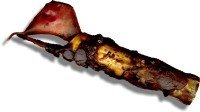 BATIK processing falls into three categories: CAP, TULIS and COMBINASI (combinasi simply refers to a combination of tulis and cap).
BATIK processing falls into three categories: CAP, TULIS and COMBINASI (combinasi simply refers to a combination of tulis and cap).
|
|
|
|
|
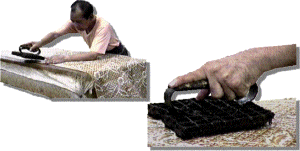
|
BATIK CAP processing starts with the application of wax using a CANTING CAP (stamp) which has a design on it. |
|
|
|
| BATIK TULIS starts with a design on paper. Then that design is copied onto the cloth. | 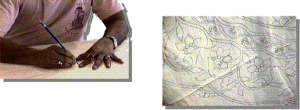
|
|
|
|
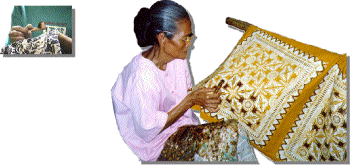
|
The next step of the process, is for klowong (wax) to be applied with a CANTING. A CANTING may have multiple tips or just one and the diameter of the hole through which the wax is poured also varies depending on the needs of the design. |
|
|
|
| The kain (cloth) is then dyed and boiled to remove the wax. | 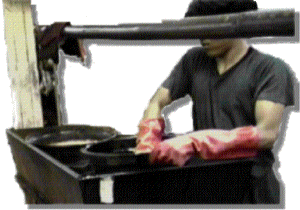
|
|
|
|
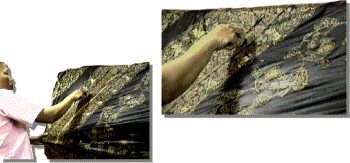
|
The wax is also removed with a special knife, called a CAWUK. |
|
|
|
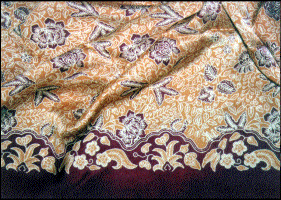 Batik from the shop of Sugeng Madmil in Trusmi. |
|
|
|
|